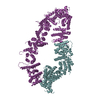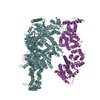+Search query
-Structure paper
| Title | The structure of neurofibromin isoform 2 reveals different functional states. |
|---|---|
| Journal, issue, pages | Nature, Vol. 599, Issue 7884, Page 315-319, Year 2021 |
| Publish date | Oct 27, 2021 |
 Authors Authors | Andreas Naschberger / Rozbeh Baradaran / Bernhard Rupp / Marta Carroni /    |
| PubMed Abstract | The autosomal dominant monogenetic disease neurofibromatosis type 1 (NF1) affects approximately one in 3,000 individuals and is caused by mutations in the NF1 tumour suppressor gene, leading to ...The autosomal dominant monogenetic disease neurofibromatosis type 1 (NF1) affects approximately one in 3,000 individuals and is caused by mutations in the NF1 tumour suppressor gene, leading to dysfunction in the protein neurofibromin (Nf1). As a GTPase-activating protein, a key function of Nf1 is repression of the Ras oncogene signalling cascade. We determined the human Nf1 dimer structure at an overall resolution of 3.3 Å. The cryo-electron microscopy structure reveals domain organization and structural details of the Nf1 exon 23a splicing isoform 2 in a closed, self-inhibited, Zn-stabilized state and an open state. In the closed conformation, HEAT/ARM core domains shield the GTPase-activating protein-related domain (GRD) so that Ras binding is sterically inhibited. In a distinctly different, open conformation of one protomer, a large-scale movement of the GRD occurs, which is necessary to access Ras, whereas Sec14-PH reorients to allow interaction with the cellular membrane. Zn incubation of Nf1 leads to reduced Ras-GAP activity with both protomers in the self-inhibited, closed conformation stabilized by a Zn binding site between the N-HEAT/ARM domain and the GRD-Sec14-PH linker. The transition between closed, self-inhibited states of Nf1 and open states provides guidance for targeted studies deciphering the complex molecular mechanism behind the widespread neurofibromatosis syndrome and Nf1 dysfunction in carcinogenesis. |
 External links External links |  Nature / Nature /  PubMed:34707296 / PubMed:34707296 /  PubMed Central PubMed Central |
| Methods | EM (single particle) |
| Resolution | 2.9 - 4.8 Å |
| Structure data | EMDB-13391, PDB-7pgp: EMDB-13392, PDB-7pgq: EMDB-13393, PDB-7pgr: EMDB-13394, PDB-7pgs: EMDB-13395, PDB-7pgt: EMDB-13396, PDB-7pgu:  EMDB-13397:  EMDB-13398:  EMDB-13399: |
| Chemicals |  ChemComp-PEV:  ChemComp-ZN:  ChemComp-HOH: |
| Source |
|
 Keywords Keywords | SIGNALING PROTEIN / Neurofibromin / Cancer / GAP / Ras / Neurofibromatosis type 1 |
 Movie
Movie Controller
Controller Structure viewers
Structure viewers About Yorodumi Papers
About Yorodumi Papers















 homo sapiens (human)
homo sapiens (human)